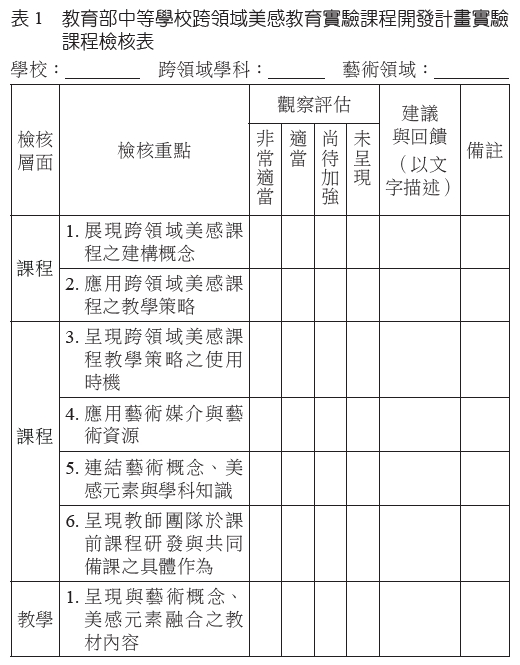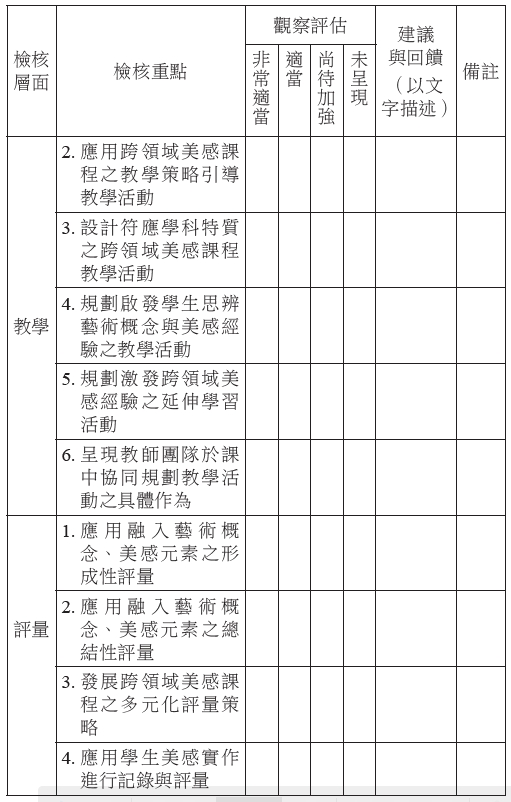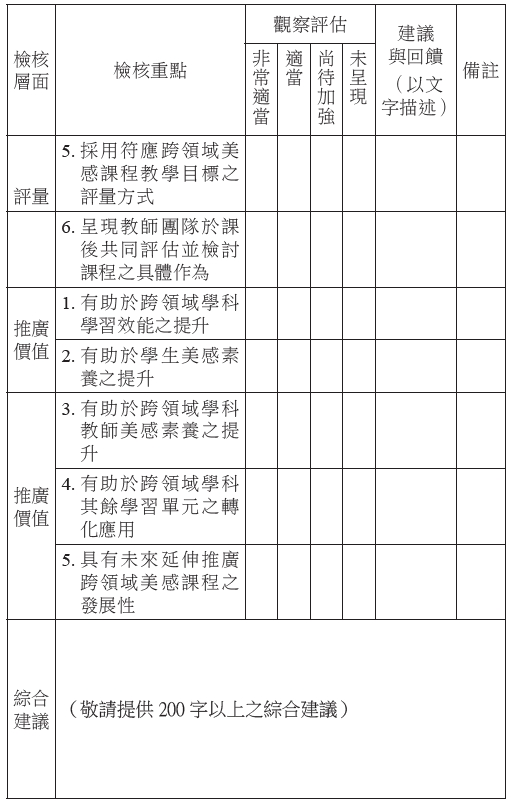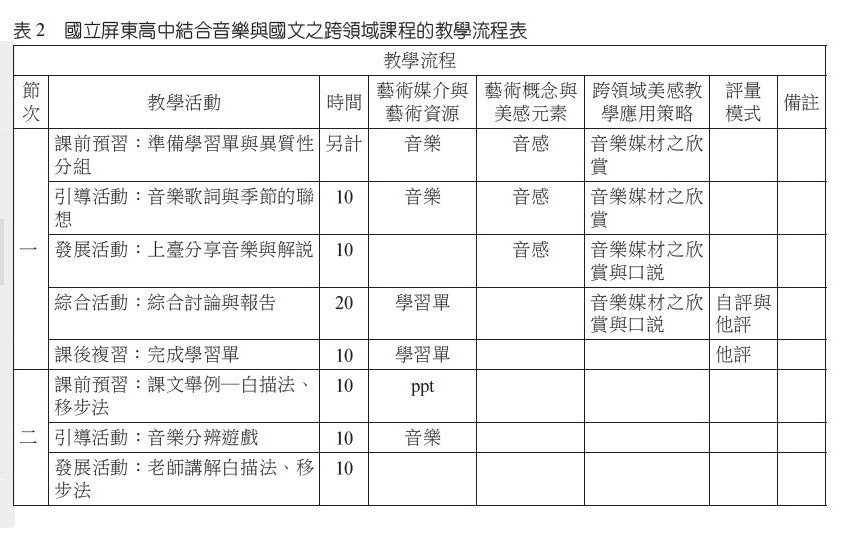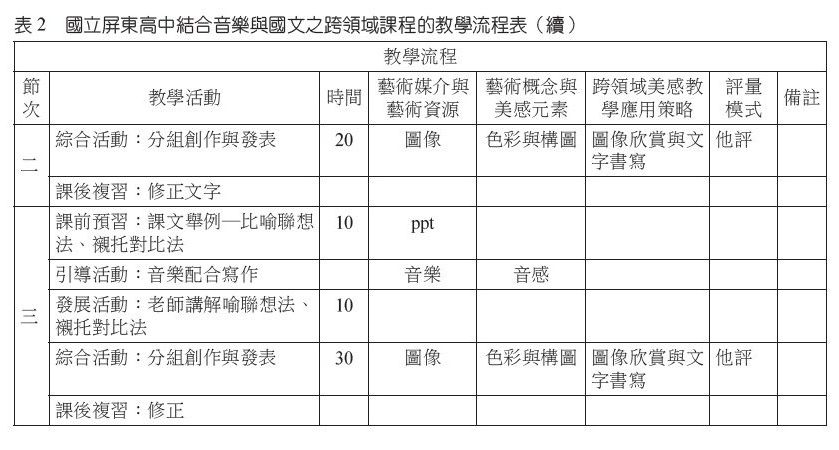Assessment methods and learning responses for cross-field aesthetic courses
Project co-host Professor Lin Xiaoyu, Department of Music, Taipei City University
1. Preface
The word aesthetic means to feel and perceive; aesthetics is a science that explores feelings, concepts, judgments, etc. related to beauty, aiming to make up for the lack of rational knowledge through aesthetics; aesthetic education is education for aesthetic sense, which is a person with the ability to The meaning-oriented task is mainly to enable learners to become individuals who are aware of the living world through art learning. In this context, the focus of aesthetic education is that learners can feel and perceive the things they should pay attention to, and are willing and able to feel and recognize the world they live in; and the curriculum characteristics of aesthetic education are centered on activity experience. An experiential course in which learners can be inspired to create personal freedom but at the same time construct social justice (Lin Xiaoyu, 2015).
There are many related concepts about aesthetic education, and there are similarities and differences between them. Su Yahui (2008) divided it into "aesthetic education" which emphasizes the study of aesthetic knowledge, and "aesthetic education" which focuses on the cultivation of aesthetic ability. and three types of "aesthetic education" that teach people how to experience experience. This article focuses on the aesthetic education of feeling experience and examines it from the perspective of teaching evaluation.
Aesthetic education is an education that cultivates aesthetic experience and emphasizes the practical application of aesthetics in daily life. Since it is experience, it involves the communication and transmission of beauty as well as the perception, emotion, and intellectual levels. The generation of aesthetic experience depends on people using their own sensitive body and soul to perceive the special properties of the outside world, feel and understand the beautiful experience, and even generate practical desires or actions. Greene (1995) regards aesthetic education as a process of cultivating reflection and emotional expression through viewing, listening, rhythm and feeling, and this process can be obtained through participation in artistic activities (cited in Chen Yuting, 2007). Huang Hanchang (2009) also echoed Greene's belief that the purpose of aesthetic courses and aesthetic education is to remind students of their awareness of existence so that they can reflect and be conscious, so as to take action and transform their own society.
The value of such experience or education is diverse. First, studying aesthetics can give us systematic knowledge about beauty, broaden our horizons, and achieve the purpose of seeking knowledge. Studying aesthetics can also provide a basis for thinking about ethical norms, allowing people not only to abide by the norms, but also to cultivate their emotions and shape their lives according to their own nature and temperament, which helps to cultivate themselves as a person. In addition, studying aesthetics is helpful for specific practices such as artistic creation and art criticism, helps to establish our advantages in daily life, and obtain benefits and competitiveness that can be applied in society. In summary, aesthetic education is reflected in individuals through appropriate behavior, respect and tolerance, multi-dimensional sensitivity, both convergent and diffuse thinking, and the pursuit of a tasteful life style. Aesthetic education is reflected in the relationship between people and can help individuals and society to harmonize, develop cultural identity, enhance social atmosphere, and shape social citizens.
Greene (2001) advocates that art education is the first step in aesthetic education. Chen Jinmu (1999) advocates that art education is not a single subject with clear barriers, but should practice art from a cross-field integrated perspective and even integrate life experience. Greene collaborated with schools at Lincoln Center in New York to promote the cross-domain SAS (Society/Art/Science) aesthetic education integration model, which uses the aesthetic qualities of art to focus on issues in life, crosses subject boundaries, and integrates science and society. Learning (quoted from Hong Yongshan, 2012). Aesthetic education should provide students with an open space for exploration, approaching it from the perspectives of different fields, in order to gain multiple cognitions and bring insightful meanings.
It can be seen from the above that no matter whether the definition of aesthetic education is broad or narrow, the category of aesthetics is mostly related to art. Art education has an unshirkable responsibility in shaping students' aesthetic character. Aesthetic education is education that cultivates aesthetic experience and emphasizes the practical application of aesthetics in daily life. The value of such experience or education is diverse, for individuals or society, in pursuit of knowledge, life, and application.
However, the development of aesthetics cannot be achieved overnight. It requires school education to deepen artistic literacy into curriculum and teaching in order to achieve the level of aesthetic life education for all nationals. The learning process must cultivate students to know, love and appreciate beauty through aesthetic education. , the ability to coordinate inner needs such as beauty and external performance, and then enhance the spirit and soul to a state of intellectual clarity. To achieve this goal, art education in national primary and secondary schools must be implemented steadily to achieve results (Ministry of Education, 2015).
Curriculum, teaching and assessment are in a mutually reinforcing relationship, and assessment also plays a key role in cross-field courses. This article explains the teaching evaluation and learning response of cross-field courses. It is hoped that such a description can guide feasible cross-field course evaluation modules and strategies.
2. Introduction to Teaching Evaluation of Art Subjects
Teaching evaluation refers to teachers using various methods to collect students' learning data, including quantitative data, such as test scores and homework scores; qualitative data, such as anecdotal records, observation sheets, etc. After careful analysis, synthesis and explanation, value judgments are made on students' learning situations (Li Kunchong, 1999; Lin Xiaoyu, 2007; Ji Yazhen, 2007; Guo Shengyu, 2004).
Art subject teaching evaluation means that art subject teachers collect students’ learning materials as the basis for teaching and curriculum decisions. Art subjects include music, visual arts, drama, dance and other forms and categories. Emotion is one of the elements. The complexity of teaching evaluation is even greater than that of other subjects. Cross-field courses connect subjects in different fields. , the teaching objectives involved are more extensive, and the difficulty of assessment is therefore increased. Therefore, in order to properly evaluate students’ learning behaviors in cross-field courses, we must have a deep understanding of the course positioning and teaching objectives, so that we can formulate appropriate evaluation methods to understand students’ learning outcomes and reflect on ways to improve them.
Based on the nine-year consistent curriculum syllabus for the arts and humanities learning area (referred to as the 97 syllabus) (Ministry of Education, 2008), the evaluation principles for teaching evaluation are discussed as follows:
1. Evaluation principles: The teaching evaluation in this learning area should be based on ability indicators and teaching material content, adopt multiple evaluation methods, and take into account both formative and summative evaluation. It can be carried out through practical assessment, dynamic assessment, real assessment, file assessment and other methods to present students' diverse learning performance.
2. The scope of assessment includes the learning process and outcome evaluation of exploration and performance, aesthetics and understanding, practice and application.
3. Evaluation methods
(1) Observation is the most commonly used method in the art field, and is often used together with exploration, operation, demonstration, verbal description, explanation, situational judgment, value system and other methods.
(2) Art evaluation covers cognitive, motor skills, affection, social responsibility and other artistic behaviors, including knowledge, awareness, exploration, organization, evaluation, operation, cooperation and interaction and other behavioral levels.
(3) During the assessment process, students’ performance in various art learning activities is recorded, and quantitative data (such as art cognitive tests, aesthetic attitude scales, performance works, literacy index tests, etc.) are used together with qualitative data (Such as: observation records, role plays, self-study plans, aesthetic notes, artistic life planning, etc.) to help students achieve basic abilities in art learning and artistic literacy.
(4) Make good use of other assessment methods, such as questions and answers, questionnaires, anecdotes, tests, self-reports, rating scales, checklists, benchmark assessments, discussions, etc., to truly grasp the teaching objectives.
The above-mentioned evaluation principles of the 97-syllabus teaching evaluation reflect many important syllabus teaching evaluation concepts. First of all, art teaching emphasizes the diversity of students’ learning performance, so the assessment methods and assessment opportunities should also be diverse. Secondly, the scope of teaching evaluation of arts and humanities does not deviate from the curriculum goals of arts and humanities - "exploration and expression, aesthetics and understanding, practice and application", which illustrates the necessity of closely integrating the teaching evaluation of any subject with the curriculum. Furthermore, the teaching evaluation of arts and humanities should take into account balance. For example, both process and results should be emphasized. Cognition, motor skills, emotion, and social responsibility should cover goals at different levels, and both quantitative and qualitative data should be available.
Although the art education standards or syllabuses of various countries have different considerations or terms for the content of teaching evaluation, research shows (State Education Agency Directors of Arts Education, 2014) that the art curriculum goals of each country do not deviate from three major categories, namely "production" "generating/problem solving" is equivalent to "creating" in the American curriculum standard (Consortium of National Arts Education Associations, 1994); "expressing/realizing" is equivalent to the American curriculum standard (Consortium of National Arts Education Associations, 1994) "Performing" and "responding/appreciating" in the curriculum standards are equivalent to "responding" in the American curriculum standards.
Based on this, the arts subjects involved in cross-disciplinary courses, whether it is music, visual arts, drama (performing arts) or dance, when combined or integrated into other subjects, should be able to help students achieve "output/problem solving" ”─For example, proposing or conceiving ideas and strategies, organizing and developing these ideas or strategies, refining the aforementioned ideas and completing works of art. "Performance/Practice" refers to the completion of a certain artistic expression through analysis, interpretation, selection, and refinement of artistic works - such as singing a song, painting a painting, performing a play, or dancing a fragment. In terms of "response/appreciation", you may respond to works of art or teaching - such as explaining your feelings after viewing or listening to works of art, analyzing and commenting on classmates' paintings... In other words, in cross-disciplinary aesthetic education courses, even if art subjects are used to integrate into disciplines, their teaching objectives should still reflect the characteristics of their disciplines, through "output/problem solving", "expression/practice", " Different aspects such as "response/appreciation" are in line with the characteristics and essence of the discipline.
Participate in contemporary teaching evaluation trends
In recent years, various countries have actively developed appropriate modules for teaching assessment and developed their own national standards. For example, the National Assessment of Educational Progress in the United States conducts national art assessments based on the American National Standards for Art Education. The Australian Province of Queensland has also promulgated its art curriculum and assessment. Our country has announced basic literacy indicators for sixth and ninth graders in the field of arts and humanities learning, and based on the nine-year consistent arts and humanities curriculum syllabus, developed national middle school learning achievement evaluation standards (National Taiwan Normal University Psychological and Educational Test Research Development Center, 2015).
It can be seen from this that emerging assessments are gradually receiving attention and are widely used in teaching assessment in various subjects. Linn and Gronlund (2000) proposed the trend of teaching evaluation in the United States, including using evaluation as a symbol and means of educational reform; scientific and technological progress, computerized tests are becoming increasingly common; the state attaches great importance to evaluation; and the public pays attention to testing and evaluation.
After measuring the current situation of domestic teaching evaluation and the trend of educational reform, Li Kunchong (1999) pointed out that the development trend of domestic teaching evaluation is: 1. Integrate teaching and evaluation, no longer focus on summative evaluation, and appropriately use placement and formation Sexual, diagnostic and summative assessments guide teaching; 2. Teachers’ abilities in assessment design, implementation and result interpretation are improved, and the development is towards professional assessment; 3. Development towards multiple assessments, including diversification of assessment methods; The content is life-oriented and diversified, focusing on the assessment of cognition, skills, emotions and high-level thinking abilities; the assessors are diversified, and in addition to teacher ratings, students' self-assessments, peer assessments and parent participation assessments are also used. Method; the results are diversified. In addition to using the relative position of students in the group as the evaluation criterion, it can also present the progress results of students' self-efforts. 4. Assessment is of great concern to the general public and parents; 5. Assessment is computerized and networked. Computers can store a large number of test questions, and select appropriate combinations of questions based on students' abilities, backgrounds and response responses. This saves manpower and time compared with paper-and-pencil tests. Therefore, computer-assisted testing systems are gradually gaining popularity in schools. Due to the development of the Internet, online testing systems have been developed at home and abroad, and online assessment is bound to become the trend of assessment in our country.
Guo Shengyu (2004) advocated that emerging assessments have the following characteristics: 1. Pay attention to the assessment of high-level abilities: students are required to integrate the knowledge they have learned to answer questions, so students need to use high-level thinking and critical skills; 2. Emphasis on the use of real problems: The problems used in emerging teaching assessment are real-world problems, that is, problems that students will encounter in real life; 3. Use multiple evaluation methods: such as paper-and-pencil and non-paper-and-pencil tests, and demonstrations Performances, research projects, experiments and oral presentations, etc., can take into account the individual differences of students in the class; 4. Use multi-dimensional scores: including teacher evaluation, parent comments and students' self-evaluation and reflection; 5. Pay attention to the process Far better than the results: Traditional assessment only focuses on the evaluation of learning results and ignores the evaluation of the learning process. However, the new assessment emphasizes the evaluation of problem-solving thinking skills and pays more attention to the learning process than the learning results.
In addition, the National Middle School Learning Achievement Assessment Standard (National Taiwan Normal University Psychological and Educational Testing Research and Development Center, 2015) describes the reasons for its development as follows: 1. To provide an assessment reference basis corresponding to the curriculum and transform it into a standard-referenced one. Assessment; 2. Provide instant teaching feedback; 3. Promote teachers’ professional development; 4. Establish a mechanism for academic ability monitoring; 5. Integrate assessment concepts with international standards.
It can be seen that, whether at home or abroad, teaching evaluation has attracted more and more attention from the public, and the spirit of multi-evaluation has been implemented at all levels, including evaluation methods, evaluation content, evaluators, result interpretation, etc. In addition, instead of focusing on memory assessment in the past, teachers began to use different methods of assessment to cultivate students' high-level problem-solving abilities.
Each subject area has its own unique academic characteristics and the applicable assessment methods are different. However, the assessment of all subjects is developed based on the above theory. Therefore, in order to explore the connotation of cross-field teaching evaluation, we must first have a comprehensive understanding of the connotation of teaching evaluation in order to deeply reflect the spirit of teaching subjects.
4. The application of contemporary teaching assessment trends in cross-field aesthetic courses
This article elaborates on four important trends in cross-field teaching evaluation in more detail, including standard-reference orientation, authentic assessment orientation, student learning-centered multi-data orientation, and meaning-seeking orientation. Through in-depth understanding, the comprehensive effectiveness of the course will be further exerted.
1. Standard Reference Orientation
In teaching assessment, according to the interpretation method of assessment scores (Guo Shengyu, 2010), assessment can be divided into norm-referenced assessment and criterion-referenced assessment. The purpose of norm-referenced assessment is to distinguish individual differences among students. After the assessment, the student's score is compared with the scores of other students to determine the quality of the student's performance, that is, based on the relative position of the student's score in the group. , to explain the meaning of its fraction. Criterion-referenced assessments, on the other hand, interpret students' scores based on how well they have learned specific knowledge, mastered the content, or met predetermined standards.
The trend of contemporary teaching evaluation is towards standard reference. By formulating standards in advance and using emerging evaluation tools such as scoring rubrics, students' learning achievement performance is described through absolute learning achievement performance standards for teaching evaluation. quantity. Criteria-referencing attaches great importance to the discipline-specific nature of teaching evaluation, transforming the content of the syllabus into specific, measurable goals, achieving the important "communication" purpose of teaching evaluation, and getting rid of rankings or competing with other people's scores. The myth of comparison, towards the teaching goal of adaptive education.
Based on this trend, if interdisciplinary courses can establish a firm foundation for curriculum development, clarify the appropriate teaching objectives for each subject, and set relevant performance standards, it will better reflect the professionalism of interdisciplinary courses.
2. Authentic evaluation orientation
The rise of authentic assessment is influenced by the constructivist learning theory. Constructivism emphasizes allowing students to engage in meaningful learning through actual participation in activities and pays attention to the context of learning. Therefore, assessment needs to be conducted in an appropriate context. measurement, so that the evaluation procedure is a true evaluation (Darling-Hommond, Beverly, 1995). Authentic assessment must be closely coordinated with curriculum, teaching and student development, and it can only work if it is similar to the student learning environment.
Wiggins (1990) proposed the following explanation of the characteristics of authentic assessment relative to traditional assessment methods:
(1) Students must use their knowledge efficiently in real assessments; traditional tests often test students’ ability to identify or remember unreal situations.
(2) In real assessment, students are given the highest priority tasks and challenges that can be simulated in many teaching activities; while traditional tests are often limited to paper-and-pencil tests and single-answer tests.
(3) Authentic assessment focuses on whether students can construct deliberate, thorough, appropriate and self-defeating answers or outputs; while traditional tests often only focus on whether students can choose or write correct answers without paying attention to the reasons.
(4) Authentic assessment achieves reliability and validity by strengthening appropriate scoring indicators; traditional tests only focus on objective items, so they only care about correct answers.
(5) The tasks of real assessment are mostly ill-structured problems, which allow students to practice complex real-life situations in advance; while traditional tests are mostly shallow and scattered assessments like repeated exercises.
Authentic assessment is used to determine students' progress in knowledge and skills while participating in real-world activities (Asmus, 1999). Therefore, the teaching evaluation of art subjects is more advantageous than other areas in this regard. After all, when students play music, perform sketches or dramatic performances, they are demonstrating their learning results in the form of public activities. However, if the curriculum includes the teaching of other subjects, how to make each other's evaluations deeper rather than shallower, and indeed in line with the spirit of true evaluation, depends on the efforts of all parties.
The evaluation standards for students' learning achievements in national middle schools are presented in the form of scoring standards, and the connotations of each evaluation standard are clearly defined based on the content of the standards drawn up in advance. Take the "Remarks" of the music subject as an example: song singing performance ability can include the following two aspects, with examples of its connotations as follows: (1) Singing skills: singing posture, breathing, resonance, typhoon, etc. (2) Performance of the work: performance of pronunciation, melody, rhythm, intensity, speed and other musical elements. Instrumental performance ability can include the following two aspects, with examples of connotations as follows: (1) Performance skills: playing posture, specific instrument performance techniques (such as recorder luck, tongue movement, finger movement, etc.), voice independence, etc. (2) Performance of the work: the performance of musical elements such as melody, rhythm, intensity, speed, etc. Appreciation ability can include the following two aspects, with examples of connotations as follows: (1) Content of works: musical elements (such as rhythm, melody, dynamics, speed, timbre, texture, etc.), musical structure (such as musical form, type of music, etc.) , style), performance form (such as: solo/solo, chorus/ensemble, etc.). (2) Expression of works: musical vocabulary, cultural characteristics, feelings and responses, analysis and comparison, etc.
The examples cited above all hope to reflect the learning process and results in a deeper way by setting clear indicators, helping cross-field teachers collect data, and ultimately improving teaching effectiveness.
3. Multiple data orientation focusing on student learning
Cross-field assessment attaches great importance to students' learning responses and uses students' learning responses as the benchmark for teaching evaluation. Curriculum standards, in this context, are not used to guide teachers in teaching procedures; rather, they are intended to define what students should know and be able to do.
McTighe (2011) lists the characteristics of cornerstone assessment as follows: (1) It is based on the curriculum rather than an add-on; (2) It deepens and broadens with the level; (3) It establishes the true context of performance; (4) It is transparent Assess understanding and learning transfer through real performance; (5) Integrate 21st century abilities within the subject such as critical thinking, technology use, teamwork, etc.; (6) Evaluate student performance using pre-developed scoring rubrics ; (7) Encourage teachers to improve teaching and allow students to engage in meaningful learning; (8) Accumulate the content of student files.
These eight points illustrate that teaching evaluation is both a means and an end. It is hoped that through an appropriate teaching evaluation process, we can return to a multi-data orientation focused on student learning.
4. Direction of pursuit of meaning
The newly launched National Core Arts Standards (State Education, Agency Directors of Arts Education, 2014) in the United States not only emphasize the traditional creation, implementation, and response of art subjects, but also attach importance to "connection" ( connecting) related links. Its definition of connection is "relating artistic ideas and work with personal meaning and external context." The goal is "Students will: 10. Synthesize and relate knowledge and personal experiences to make art". "Students will: 11. Relate artistic ideas and works with societal, cultural and historical context to deepen understanding."
From the above, it can be seen that cross-field teaching evaluation strives towards the direction of students' meaning construction to avoid evaluation from falling into the narrow dilemma of simply assisting teachers in scoring.
5. Basic concepts of cross-disciplinary teaching evaluation
1. Basic concepts
To properly implement teaching assessment in cross-disciplinary courses, basic concepts must be understood. Specifically, teaching evaluation needs to collect relevant information about students’ learning performance, which can generally be divided into two categories: subjective information and objective information. Subjective data refers to informal and unsystematic observations and interpretations made by teachers, which are easily affected by the teacher's own experience, knowledge, emotions, intuition and bias. In contrast, objective data are not affected by teachers' emotions and biases (Boyle, Radocy, 1987). Cross-field subjects have different characteristics. Teachers need to choose the assessment method that can best measure students' true performance based on the actual teaching situation.
In addition, teaching evaluation can be divided into overall and partial (Boyle, Radocy, 1987). As the name suggests, the holistic assessment attaches importance to the overall consideration during assessment; its biggest advantage is that it is economical, can be constructed quickly and is easy to score. However, because all characteristics are listed together, it is difficult to distinguish the differences between characteristics. Separation, it is easy to produce different performances but get the same score. In other words, although the overall assessment provides descriptions of different levels of overall performance and more directly gives an overall judgment that is consistent with the grade, it lacks a diagnostic function and cannot easily provide students with clear feedback.
Partial assessment uses each sub-item to be clearly listed to help inform the teacher's assessment direction and the direction of students' efforts. The most important feature of analytical evaluation is to divide a work, process or learning performance into different dimensions so that it can be evaluated one by one. If necessary, the scores of each criterion can be summed or weighted to form an overall score. or hierarchy (Hibbard, Wagner, 2003; Mabry, 1999). Since each dimension is divided into levels, and the performance characteristics of each level are further explained, it allows students to understand their own performance and areas for improvement, and promotes their continuous self-evaluation (Zhang Lili, 2002). The above shows that analytical assessment closely links teaching and assessment and has a profound diagnostic function. However, the shortcomings of the time, financial resources and difficulty in constructing the test often make people hesitate to move forward.
2. Emerging Assessment Tools
In order to highlight that teaching evaluation should not only focus on results, but also emphasize and pay attention to students' learning process, Hickey (1999), Brophy (2000) and others proposed the use of checklists, rating scales and scoring criteria as emerging musical creativity assessment methods. measuring tools.
Educational scholars often advocate that the assessment of musical creativity should focus on both process and results, balancing cognition, skills and emotions, and that rating scales and checklists are suitable for teachers to use to check students' interests, attitudes and behavioral performance (Chen Yinghao, Wu Yuyi , 1991), is forward-looking in interdisciplinary courses.
(1) Checklist
Checklists refer to listing some specific behaviors or traits, and then recording the "yes" or "no" occurrence of the behaviors or traits based on the observation results (Guo Shengyu, 2004). That is, according to the teaching objectives or assessment objectives, the specific characteristics, behaviors or skills that students should have and can be observed are divided into items one by one in detail according to the order of occurrence or other logical rules, and listed in short and clear behavioral or skill narrative statements. Behavior or skill standards (Li Kunchong, 1999). The following summarizes the explanations of the principles of checklist preparation by three scholars: Guo Shengyu (2004), Li Kunchong (1999), and Yu Minning (1997): (1) Clearly identify the specific actions and characteristics of the behavior, including clearly identifiable wrong behaviors; (2) Observe one behavior listed in the table at a time; (3) The table should be simple and clear, and instructions for use should be included; (4) The views of teachers, students, and parents should be taken into consideration, and space for joint participation in evaluation should be allowed; (5) Users should understand the connection between the checklist and observation activities, including how to observe, what to observe, how to record, etc.
As for the scoring method of the checklist, scholars hold different views. Yu Minning (1997) pointed out that the results of the checklist evaluation are qualitative data rather than quantitative data. Li Kunchong (1999) advocated that the checklist can be quantified, and proposed three scoring methods: presenting the total score, presenting the overall grade, and presenting the rights and wrongs of each check item.
(2) Rating scale
Rating scales refer to a set of scales used to judge students' behaviors or traits and can indicate the different levels of students in each standard. They can be used to evaluate students' learning attitudes, strategies, interests, personality, or affection. Development status (Li Kunchong, 1999). It usually includes a set of characteristics or qualities to be judged, and some types of scales indicate the degree to which each attribute is present (Guo Shengyu, 2004; Zou Huiying, 2003); that is, the rating scale has two elements: (1) "Criteria" (criteria, or standards, levels, characteristics) are not only an important part of students' works or performance, but also the key to the quality of the work or performance; (2) "scales" (scales, or Gradations of quality, or levels, refer to the degree to which a student's work or performance achieves in various standards, or the scores obtained, and can be scored using quantitative, qualitative or both qualitative methods. Expression. Rating scales can generally be divided into three categories, namely numeric rating scales, graphic rating scales and descriptive graphic rating scales.
Many scholars have proposed principles for the preparation and use of rating scales (Yu Minning, 1997; Li Kunchong, 1999; Guo Shengyu, 2004; Translated by Zou Huiying, 2003). The author summarizes it as follows: (1) The assessment standards must meet the teaching objectives; (2) The criteria for evaluation must be directly observable; (3) The criteria for evaluation and the scores for each grade must be clearly stated; (4) The number of grades for evaluation should be three to seven; (5) The number of evaluation items should be one at a time; (5) The number of evaluation items should be one at a time; 6) The evaluation results should integrate the scores of several observers.
(3) Scoring criteria
Rubrics are a narrative assessment tool that consists of a set of criteria for evaluating student performance, presented in a graded manner, and each grade has a specific set of text descriptions (Hart, 1994) , to distinguish different degrees of behavioral development or characteristics. There are many Chinese translations of the scoring rubric, including scoring criteria, scoring procedures, scoring indicators, scoring specifications, scoring standards, evaluation rubrics, benchmark evaluation scales, and so on.
The author advocates that the scoring rubric is a further step forward from the rating scale. As mentioned before, the rating scale has two elements, "standard" and "measuring scale"; in addition to the above two elements, the rating criterion adds a third element, namely "descriptors", which provide quantitative Text descriptions, specific characteristics or examples of each performance level on the ruler (Chen Mingyin, 2002; Popham, 2000; Wiggins, 1998).
Hickey (1999) suggests steps for establishing a scoring rubric:
1. Determine the composition criteria of the final work: Describe in detail the composition criteria of three to five works.
2. Imagine the level of quality that each criterion can achieve in the student's work: Describe the characteristics of the criterion in detail. Try to make a short paragraph of three to five sentences describing each criterion.
3. Arrange two opposing descriptions at opposite points of each standard quality line.
4. Write the quality content at each level between the two opposite descriptions so that they can appropriately fall between the opposite points of the quality line.
5. Repeatedly review the positioning and placement of each evaluated criterion at each level in the continuum.
(4) Archive evaluation
Portfolio assessment refers to the purposeful collection of student works to show their efforts, progress and achievements in a certain field of study. Each student prepares his or her own portfolio, and the teacher provides content selection guidelines, and then discusses the content of the portfolio with students individually and allows students to participate in evaluation together (Guo Shengyu, 2004: 180).
Archival evaluation has many advantages (Ji Yazhen, 2007; Guo Shengyu, 2004; Ou Canghe, 2004; Liu Anyan, 2003; Linn and Gronlund, 2000). First, the assessment of the files meets the individual differences and needs of students; second, the systematic collection of student data over a long period of time can understand the progress of students; third, the files contain the products of class teaching, making it easy to integrate assessment and teaching; fourth, Encourage students to actively participate in data collection, self-evaluation and self-examination, improve students' self-understanding, and develop self-evaluation skills; finally, the files provide specific examples of students' works, which can be used as a tool for teachers and parents to communicate about students' learning progress. The limitations of file assessment include the following points: it is time-consuming for teachers to review file materials and meet with students; the reliability and validity of the assessment are difficult to establish, and without clear scoring standards, it is easy to cause unobjective and unfair scoring; teachers must have high standards Assessment knowledge and sensitivity; the file storage folder must have ample space.
Ward and Murray-Ward (1999) divided archive evaluation into three categories: (1) Best work archive: aims to collect students’ best works. Since it does not include students’ daily learning performance or progress, it does not have The function of guiding teaching; (2) Growth and learning progress files: The purpose is to understand students' learning and thinking progress. The collected information includes students' works at various stages, tests, observation records and parents' opinions... etc.; (3) ) Pass-portfolio assessment: It is a summative assessment tool that aims to determine whether students have achieved expected performance levels. It is usually used in education decisions such as promotion, repetition, pass or fail, or as a summary score during a period of study. , therefore the archive content evaluation standards or procedures must be clearly defined.
The emphasis on archival assessment in art education began with "Toward the Arts" researchers at Harvard University in the United States. They advocated it in order to help students grow their archives and propose feasible strategies for authentic evaluation. In the art file evaluation, all students' works are placed in folders, including compositions, performance recordings, music appreciation records, reflections, emotional perceptions (feelings), questions, and collected music background information. wait.
(5) Study sheets and other
Based on the needs of the teaching content, the teachers or R&D personnel of the learning unit present the teaching content in a beautified way that requires students' attention and focus. In this project, many school teachers collect students’ learning responses through worksheets and other methods.
3. Analysis of research tools for cross-field aesthetic experimental courses
Based on the concept of teaching evaluation, one of the research tools of this project, the "Experimental Course Checklist for the Cross-disciplinary Aesthetic Education Experimental Curriculum Development Plan for Secondary Schools of the Ministry of Education", is analyzed below to connect the theory and practice of teaching evaluation.
The analysis of Table 1 is as follows:
(1) Purpose of tool use: The above tools are intended for course evaluation, not teaching evaluation.
(2) Regarding the form of the tool: the above tool is a three-point rating scale ("very appropriate", "appropriate", "yet to be strengthened"); the "not presented" column is used to distinguish the completeness of the course content and is not included in the assessment within the level.
(3) The attributes of the data collected by the tools: The above tools do not clearly define the attributes of the data used for course evaluation, but they should be able to conduct evaluations through a variety of subjective and objective data.
(4) Coverage of the data collected by the tool: The above-mentioned tool is more inclined to itemized evaluation because it clearly lists the assessment levels during course evaluation including "curriculum", "teaching", "evaluation", and "promotion" "Value", "Others", etc., divide the evaluated curriculum program into different dimensions so that it can be evaluated one by one. If necessary, the scores of each criterion can be summed or weighted to form an overall score or grade. .
Lu, student performance
Among the expected results of this project, the main ones related to assessment and student learning are "enhancing teachers' aesthetic and creative diversified assessment capabilities to promote students' diversified learning." Here, we take three experimental courses that combine visual, music, and performing arts as examples to illustrate how each program understands student performance through teaching evaluation.
1. Examples of teaching evaluation for cross-field courses that incorporate vision
The National North Gate High School's "Ecological Department Model - Teaching Bio-Integrated Art Courses" plan is based on the fact that students' learning environment is mostly limited to the classroom, and it cannot resonate with the composition of the ecological department or teachers' experience sharing. Therefore, students were asked to make models of the ecosystem in art class. They could do it by themselves, think and make judgments, and cooperate with the guidance of the art teacher, hoping to create works that are both aesthetic and intellectual.
The scoring and rewards are done by allowing students to report in groups: each group is limited to ten minutes, of which 5-7 minutes introduce the ecosystem selected by each group, including an introduction to the environment and representative organisms; another 3-5 minutes minutes to introduce relevant environmental news, divided into land areas and water areas. The scoring items for mutual evaluation within the group include typhoon, time control, completeness of model production, aesthetics, and publicity effect.
The method of mutual evaluation between classes is that there are four classes in total and 36 groups with 9 themes in the natural group. The top two students will be selected for each topic for mutual evaluation between classes. The person with the highest number of votes for each theme will have their works displayed in the hall.
The advantages of its teaching evaluation are briefly summarized as follows:
(1) Clearly define the evaluation items, namely typhoon, time control, completeness of model production, aesthetics, and publicity effect, which will help to lock in the focus of evaluation.
(2) The standards are multi-faceted. For example, typhoon and time control involve the performance and control of publication. The completeness and beauty of model production focus on the achievement of art teaching goals. The evaluation of publicity effect evaluates the understanding of the knowledge connotation of the ecosystem, including cross-field The different teaching objectives of the disciplines bring into play the integration benefits of cross-field courses.
(3) Attach importance to multi-evaluation. Not only the evaluation items are diverse, but also methods such as mutual evaluation are used.
2. Examples of teaching evaluation for cross-field courses integrating music
National Pingtung High School allows students to experience repetition, comparison and implementation in music through music appreciation. Students collect popular songs or classical music related to the description of the seasons, and express their seasonal feelings in the lyrics or music to build their auditory imagination and perception of the seasons. Afterwards, actual writing is carried out by combining images - allowing students to use four description techniques such as line drawing, moving, metaphorical association, and contrast to combine music and images to produce results in words.
For teaching evaluation methods, this plan lists "study sheets", "tests", "game evaluation", "thematic report production", "performance practice", "audio and video recording", and "others" for selection , the evaluation model of this program is mainly carried out through the study sheets and demonstrations.
The advantages of its teaching evaluation are briefly summarized as follows:
(1) The integration of Chinese liberal arts and music emphasizes expression and ideas in high schools. Personal creativity can best be demonstrated through worksheets, which helps teachers deeply understand students’ ideas and challenges students’ high-level cognitive abilities.
(2) The evaluation unit is divided into individuals and groups depending on the teaching situation, and can cultivate and evaluate students' different abilities.
(3) Pay attention to multiple evaluations and use both self-evaluation and peer evaluation.
3. Examples of teaching evaluation for cross-disciplinary courses integrating performing arts
Kaohsiung Municipal Qianfeng Junior High School takes festivals as its main theme and carries out cross-disciplinary courses in performing arts and English classes in the "Holiday Theater - Halloween Festival Teaching" program. The advantages of its teaching evaluation are briefly summarized as follows:
(1) Based on the teaching attributes of performing arts, emphasis is placed on practical evaluation; based on the subject characteristics of English, worksheets are used to provide students with a channel for expressing words and ideas.
(2) Pay attention to multiple assessments. For example, the assessment tools are mainly through study sheets and demonstrations; mutual assessment and other methods are also used.
7. Problems to be overcome and corresponding strategies in teaching evaluation of cross-field experimental courses
From the foregoing content, the teaching evaluation challenges of cross-disciplinary courses can be summarized as follows:
1. The issue of cross-field course teaching evaluation cannot be separated from the curriculum and teaching.
The appropriateness of the teaching evaluation of cross-disciplinary courses cannot be determined purely through the improvement of teaching evaluation techniques - based on the trinity of curriculum, teaching, and evaluation, they must be fully coordinated and checked against each other.
2. Be able to communicate teaching evaluation in a language that ordinary people can understand.
Teaching evaluation has its own professional nature, and its connotation may not be fully understood in the teacher training process. Therefore, many teachers choose to use the evaluation method they are most familiar with, such as traditional paper-and-pencil tests, to evaluate teaching. Therefore, they often cannot reflect The spirit of cross-disciplinary courses, especially in the evaluation of teaching objectives in motor skills and emotions.
Anecdotal records, self-report methods, rating scales, checklists, benchmark assessments and other knowledge can indeed drive teaching evaluation to meet the trend of the times. Teachers should learn the knowledge of teaching evaluation through teacher on-the-job training and other methods; Relevant evaluation units should also use the professional terminology of evaluation in a simple and easy-to-understand manner so that educational practitioners can understand it.
3. Understanding standard reference can bring more freedom instead of limiting teachers’ teaching.
Sung (2014) made an observation on the evaluation of students' learning achievement in national middle schools in China and found that the evaluation of arts and humanities teaching has the following challenges. That is, teachers have always evaluated themselves and feel constrained by having to respond to specific indicators for evaluation. There is a sense of resistance. But in fact, criterion-referencing allows teachers to prepare assessment standards in advance, so it can help teachers deduce students' assessment results and grades in a sandbox, and allow teachers to clarify the proportion of teaching objectives before assessment. In this way, standard assessment can provide students' parents and administrators with a direction for teachers' teaching evaluation, and avoid many subsequent disputes. Its implementation is indeed necessary.
4. The high teacher-student ratio in arts subjects leads to self-limitation in the selection of assessment strategies
Among the teaching subjects in schools, art subjects usually have a higher teacher-student ratio, and there are a large number of students who need to be assessed. This causes teachers to tend to choose assessment methods that are easy to implement and easy to score, while ignoring the need for individualization and practice. Assessments that quantify or measure high-level abilities.
8. Conclusion
Cross-field curriculum teaching evaluation should respond to the development of educational trends, allowing evaluation to return to student learning instead of focusing on teacher ratings. If teachers can continue to learn the theory and practice of teaching evaluation, the spirit and connotation of teaching evaluation will also be deepened.
This article is included in "Hui Mei. Integrating Arts: Theory and Practice of Cross-Field Aesthetic Courses", Taipei: National Taiwan Normal University, Huayi Academic Publishing House, 2016

